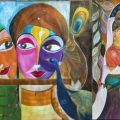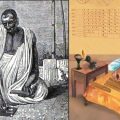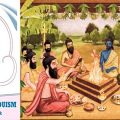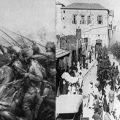Pratyasha Nithin: Invoking the Deities to Descend on Earth through Her Paintings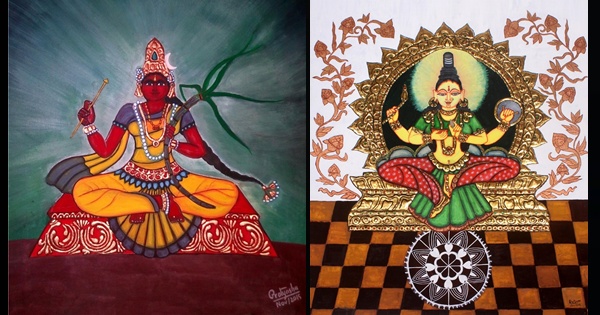
How do you connect yourself with the Almighty? Bulk of the answers will revolve around ‘prayers’ though connotations may differ from person to person. Here is an artist who connects with the Gods and Goddesses by painting them. She considers it a way to connect with them. For her, it is a way of Sadhana. In her paintings, she finds Them mysterious, beautiful and very much alive. She invokes the deities to descend on earth through her art! She loves giving life to characters of Puranic History on canvas. She is Pratyasha Nithin.
How is painting a way of Sadhana? In the words of Pratyasha Nithin, “Let me explain how it happens. You take a subject, for example, a Goddess. Now She can be calm or fierce in nature, but She is a mother. So when you research to know about Her, you behave like a curious child who wants to know more about the Mother, without caring much about her fierceness. That builds a connection. You find out how She is, what She carries, what color She is and slowly you start seeing Her. You talk to Her and you feel Her presence. With the process of painting, you want to portray Her as beautiful as She is in your mind. Though, it is almost impossible to depict on canvas or paper the exact image of the deity formed in your mind, nevertheless, the end result is that the same Goddess who manifested in your mind has now manifested on the canvas or paper as well. You have a strong connection. You know She is there in your painting. There is a satisfaction. You feel Her grace. Can you feel that kind of satisfaction in drawing any other materialistic subject? I think not.”
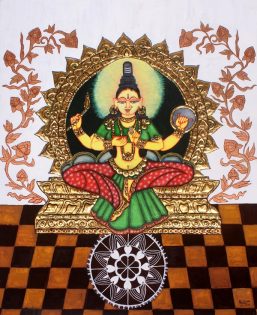
Tanjore Style painting of Kolhapuri Lakshmi
It is said by Vishvakarman that MahaLakshmi, residing in the sacred place of pilgrimage called Kolhapur is adorned with many ornaments. In Her lower right hand, there is a vessel and in the upper right hand, there is a mace called Kaumodaki. In the upper left hand, She has a shield and in the lower left a fruit called Shriphala. On Her head she carries a Linga. She is worshipped for wealth. The painting above is a Tanjore Style Painting of Kolhapuri Lakshmi by Pratyasha Nithin.
According to the description given in Prapanchasara, Goddess Chamundi has a red lustre and wears yellow robes. Her lotus face is smiling. She wears crescent moon as an ornament. She shines brightly with many ornaments which are studded with gems, pearls, and diamonds. Her arm is a little bent due to carrying a bow of sugarcane and arrows. Her eyes are wide like open lotuses. She has a fine navel and destroys hordes of enemies. Here is a Mysore Style Painting of Rakta Chamundi.
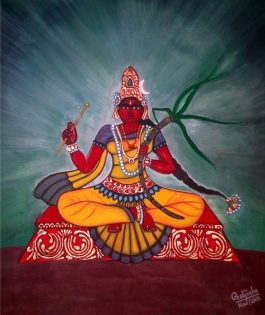
Rakta Chamundi – Mysore Style Painting
The painting medium that Pratyasha Nithin chooses is both digital and canvas. She says, “I love both mediums. I cannot say that I am attached to one, more than the other. The effects they bring are of course very different. But, it is true with every medium. A Mysore style painting brings different effect from a Madhubani style. A Madhubani style is very different from Warli style. I am a self-taught artist in both digital and handmade paintings. But, I have learnt Mysore and Tanjore schools of painting under senior artist MS Anand.”
I lived in depression for a long time and ultimately found solace in Krishna…Krishna led me from a very depressing period to a whole new life.
Not many of us are familiar with Kangiten, the Japanese form of Ganapati. He is represented as a male Ganapati and a female Ganapati embracing each other. The female’s feet rests on male and male’s head rests on female’s shoulder. The female wears a crown and a red surplice while the male wears a black cloth over his shoulder. The male has a long trunk and tusks, while the female has short ones. Male has reddish brown complexion while the female is white. Though, they are separate figures, they do not have a separate names. They are together known as “Kangitan”. The feet on feet aspect or having a single name represents the non-duality aspect of the deity. Here is an acrylic painting of Kangiten by Pratyasha Nithin.
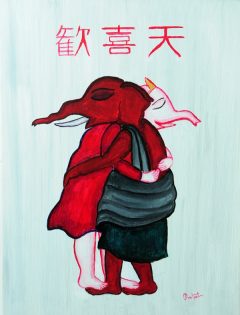
Kangiten – Acrylic painting
Pratyasha Nithin’s painting journey is sudden and unforeseen. In her words, “I remember I used to hate drawing classes when I was a child. In high school, I hated zoology just because I had to do drawings for the assignments. Overall, I never thought of being an artist and had no idea that my life will take this kind of turn.”
“I think, this changed after my mother’s death in 2006. I lived in depression for a long time and ultimately found solace in Krishna. I had downloaded a lot of Krishna paintings in my computer and used to love going through them. It is a habit we all have. We see paintings, we collect them and it is very rare that we understand how those paintings act as a link to connect you to the deity or may simply bring peace to you. But, they do.”
“Krishna led me from a very depressing period to a whole new life. In 2009, I met my husband Nithin Sridhar. It was his interest towards Hindu philosophy that created a connection between us. I once went through his collection of books in which I found this Kannada book Dhyanachitravali. The book is a collection of various sketches of different forms of deities with their dhyana mantras. Though, it was in Kannada language with which I was not familiar then, I loved the sketches anyways and for the first time willingly tried to draw a sketch of Tribhangi Krishna from it. Here is what I had drawn.”
“Though, you can see that the sketch itself is not very good, but I loved it and showed it to Nithin. He felt that I had a natural talent to draw and encouraged me to keep practicing. Many a times, I felt it was a waste of time and thought of giving up. However, I am happy that I did not.”
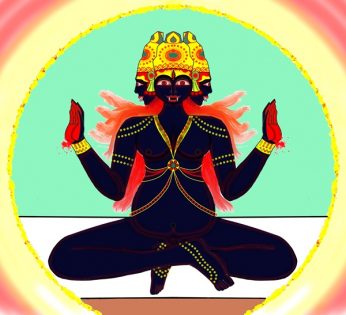
Shatruvidhvamsini – Digital Painting
Here (above) is a digital painting of Shatruvidhvamsini by Pratyasha Nithin. This painting of the deity Shatruvidhvamsini (destroyer of enemies) has been made according to the description given in Sudarshanasamhita (quoted in Sritattvanidhi). According to dhyana mantra Goddess Shatruvidhvamsini is very furious and has three heads. Her eyes are red. Her face is burning with flames of anger. Her tusks are fearsome. She has three eyes (in each face). She is naked. Her hairs are also red. Her hands are smeared with blood and her belly is big. She can ward off the enemies by showing these features.
Though, it is almost impossible to depict on canvas or paper the exact image of the deity formed in your mind, nevertheless, the end result is that the same Goddess who manifested in your mind has now manifested on the canvas or paper as well.
When asked about her source of inspiration, she says, “My husband has been the biggest inspiration. He has always inspired me in all my endeavors. In the start, as I said, he was the one to encourage me to keep practicing as much as possible; then he slowly started pushing me to experiment with different mediums. Even now, he inspires me to create every painting in the proper ancient Indian style which is to research, understand, imagine, meditate, and start only when you have a clear picture of the deity you are about to paint. Though, I cannot claim that I follow it completely but I do not start until I have a clear understanding of the various qualities of the deity and a picture in my head.”
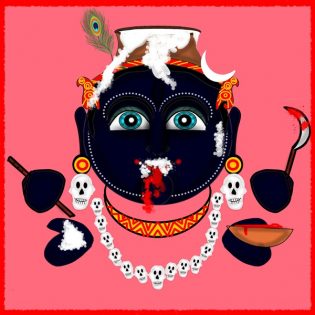
Krishna Kali – Digital Painting
The above is a digital painting of Krishna Kali by Pratyasha Nithin. This conception of Krishna as KaLi and KaLi as Krishna was predominant among the Bauls and some other devotees of Bengal. KaLi and Krishna are understood as a manifestation of the same essence in feminine and masculine form. Pratyasha Nithin has brought out this unity and non-difference of Krishna and KaLi by portraying elements associated with both the forms within a single painting. The butter, flute and peacock feather are the elements associated with Krishna where as the blood, the half moon, the necklace of skulls and the Sword are the elements associated with KaLi. Just as Kali is the dynamic aspect who dances upon Shiva, Krishna is also the Dynamic aspect who plays around with Radha and other Gopis. Hence, they both are Non-Different. Krishna is KaLi, KaLi is Krishna.
When asked about her experience in her participation in painting exhibitions, Pratyasha Nithin candidly replies, “I had exhibited my art works at Mysore Dasara Exhibition in 2015. I had also participated in Chitra-Santhe, Mysore 2015. I had been a part of the Chitraveda project- a project of illustrating Rigveda Samhita paṭha in graphic form in 2015-16. I have also designed the covers of two books of Nithin titled Musings on Hinduism and Sri Dakshinamurthy: Guru, Ishwara, and Atman. My first solo exhibition “Ganesha Sambhrama” was held from 14-16 May 2017 at Bharani Art Gallery, Mysuru.”
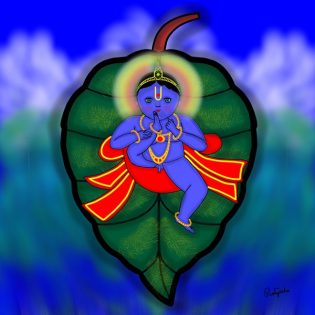
Baal Mukunda – Digital Painting
The above digital painting is of Baal Mukunda by Pratyasha Nithin. The artist has portrayed little Krishna as a child reclining on a Banyan leaf during pralaya and is inserting His feet into His mouth. This is how Sage Markandeya witnessed Him. It is said that one evening, when sage Markandeya sat on the bank of the river Subhadraa, to do his Sandhya Vandana, he witnessed the whole process of pralaya and had the darshana of Baal Mukunda. When Markandeya reached to Baal Mukunda, Mukunda sucked him in with the air He breathed. Inside, Markandeya saw hundreds of thousands of universes. He even had a glimpse of his own ashram on the banks of the Subhadra River. He saw himself sitting in meditation. Markandeya thus realized that the child was none other than Lord Narayana. Markandeya emerged again, when the baby exhaled. And suddenly there was no baby, and no other scene. He was back at his ashram.
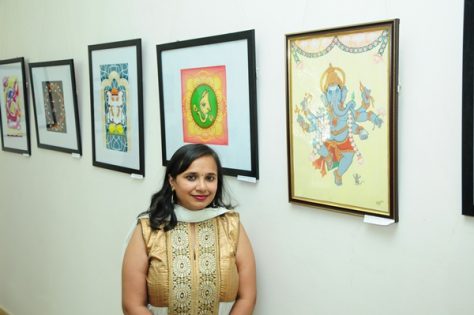
Pratyasha Nithin with her ‘painting displays’ in an exhibition
Pratyasha Nithin is a self taught artist and graphic designer from Kanpur, Uttar Pradesh, presently living in Mysuru, Karnataka. She has a bachelor degree in Computer Science. She is trained in Mysore and Tanjore schools of painting under the guidance of MS Anand, a well known artist based in Mysuru.
I had been a part of the Chitraveda project- a project of illustrating Rigveda Samhita paṭha in graphic form in 2015-16.
Pratyasha creates traditional paintings of Hindu deities based on their dhyana mantras available in various Hindu texts. She is also well-versed in Digital painting and creates colorful and exquisite Digital arts using different graphic software tools like Autodesk Sketchbook Pro, MS Paint and CorelDRAW. Apart from this, she also creates designs for different decorative products like wall art, phone cases, throw pillows, and coffee mugs and markets them on the internet.
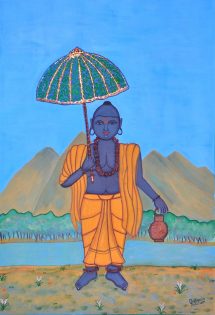
Vamanamurti – Mysore Style Painting
This is a Mysore Style Painting of Vamanamurti by Pratyasha Nithin. Vamanamurti is the fifth incarnation of Lord Vishnu. He is described as carrying a water-pot and an umbrella with His two hands.
Pratyasha Nithin leaves a message, “I would like to share here, a quote I found in an essay written by Ananda K Coomaraswamy, which says “The picture is not in the colours, but is in the heart (Hrdaya) of the artist (Karaka) before the work is done and of the spectator (Bhogin) who when the work is done has grasped its meaning.” The quote says it all.
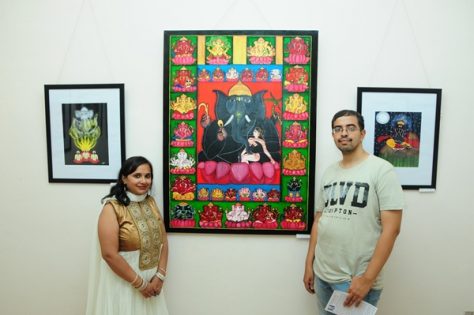
Pratyasha Nithin with Nithin Sridhar and her 32 Ganesha painting
The list of her paintings and her connect with the deities goes on and on. We shall cover more of her art katha in another post. Visit Pratyasha Nithin’s painting WEBSITE to explore more of the world of our Gods and Goddesses and of characters of Puranic History. She can be reached on FACEBOOK and TWITTER @PratyashaNithin.
Wish to feel the divine aura that Pratyasha Nithin creates through her paintings? For buying her original handmade paintings, you may contact her at pratofficial@gmail.com. International buyers can purchase her painting prints HERE. In India prints of her paintings can be purchased HERE.

